November 16, 2007
Air Date: November 16, 2007
FULL SHOW
SEGMENTS
A Green Auto Show?
/ Ingrid LobetView the page for this story
The Los Angeles Auto Show is often considered the "greenest" auto show in the U.S. But while some manufacturers are debuting environmentally-friendly cars onsite, others are offering nothing but promises of things to come. Living on Earth's West Coast Bureau Chief Ingrid Lobet stopped by the show and reports on just how green it is. (05:30)
Will Capping Carbon Clean the Air?
/ Jeff YoungView the page for this story
Lawmakers are at work on a bill that could limit the main greenhouse gas linked to global warming. But some ask what about other air pollution – the kind that sickens and kills people by the thousands? As Living on Earth's Jeff Young reports, an effort to make the climate bill clean the air is running into opposition - from some environmental groups. (05:30)
Remembering Firor
View the page for this story
Living on Earth pays homage to John Firor, planetary scientist and climate change expert, who recently passed away at 80 years of age. (02:00)
Max Capacity
View the page for this story
The atmosphere absorbs about half of the CO2 emitted from fossil fuels; the oceans and the land absorb the rest. But those systems are under strain and more CO2 is staying in the atmosphere. Host Steve Curwood turns to Professor Inez Fung of the Berkeley Institute of the Environment to find out how CO2 affects land and sea. (06:00)
Acid Oceans
View the page for this story
More carbon in the ocean means a lower pH, moving the oceans towards the acidic range of the pH scale. This causes some major problems for marine creatures and ecosystems. Host Steve Curwood talks with Dr. Ken Caldeira, an oceanographer of Carnegie Institution at Stanford University to find out what the impact of CO2 is underwater. (06:00)
Undersea Classroom
View the page for this story
A group of marine biologists are living and working deep beneath the surface of the sea in a research station off the coast of Florida. They're studying the health of nearby coral reefs and broadcasting their findings live to students all over the world. Dr. Mark Patterson is the chief scientist of the mission. He joins us from 20,000 millimeters under the sea. (04:20)
Emerging Science Note/Poplars
/ Alexandra GutierrezView the page for this story
Genetically engineered trees could be used to absorb toxins in water. Alexandra Gutierrez reports. (01:40)
Let's Talk Turkey
/ Bobby BascombView the page for this story
Almost all of the turkeys eaten in the United States are the same species: the Broad-Breasted White. But as Living on Earth’s Bobby Bascomb reports, heritage breeds of turkeys, like the Bourbon Red and Blue Slate, are making a comeback. (04:30)
Cranberries Take Centerstage
View the page for this story
An audio postcard of an old Thanksgiving standby: the cranberry. (04:00)
Not So Great Migrations
View the page for this story
The world's great animal migrations are in trouble. Whales, birds, and even insects are finding it harder to make routine journeys necessary to their survival, says ecologist David Wilcove. Host Steve Curwood talks to Wilcove about his book, "No Way Home," on the challenges migratory animals face and the challenges scientist face in tracking them. (07:35)
Show Credits and Funders
Show Transcript
HOST: Steve Curwood
GUESTS: Ken Caldeira, Inez Fung, Mark Patterson, David Wilcove
REPORTERS: Bobby Bascomb, Ingrid Lobet, Jeff Young
[THEME]
CURWOOD: From Public Radio International, this is Living on Earth.
[THEME]
CURWOOD: I’m Steve Curwood. Congress may finally pass a law to reduce greenhouse gasses, but some fear the chance to cut other life-threatening air pollution could be lost.
CARPER: I think for us to walk away from those very real threats to human health and life at a time when we could actually do it all at once and do it well, is a mistake.
CURWOOD: Also, the greener car show in L.A. and farmers who sell heritage turkeys—those that people used to raise and eat in years gone by—are now turning customers away.
STILLMAN: Almost everybody who ordered a turkey from us last year has ordered two turkeys. So I don’t know whether they’re thinking they’re going to pop one in the freezer and keep it for Christmas or something like that but people raved about the turkeys.
CURWOOD: And we’ll also go down to a cranberry bog. We have those stories and more this week on Living on Earth. Stick around!
ANNOUNCER: Support for Living on Earth comes from the National Science Foundation and Stonyfield Farm.
[THEME]
A Green Auto Show?

Green Car of the Year® nominee: Mazda Tribute Hybrid (Photo: Los Angeles Auto Show)
CURWOOD: From the Jennifer and Ted Stanley Studios in Somerville, Massachusetts—this is Living on Earth. I’m Steve Curwood. The toughest anti pollution standards for cars are in California. So it’s no wonder that the annual auto show in Los Angeles features some of the world’s greenest cars. Living on Earth’s West Coast bureau chief Ingrid Lobet drove over to the L.A. Convention Center and joins us from the auto show. Hi, Ingrid!
LOBET: Hi, Steve.
CURWOOD: So this is supposed to be the greenest car show of them all. How green is it?
LOBET: Well there’s no doubt that cars have been getting a lot cleaner, Steve. I’m not talking about fuel efficiency yet so much as conventional pollution—the car as a source of pollution. There have been tremendous gains on that front in recent years. Exhaust systems of cars have been getting much more sophisticated, and things like the air conditioning, refrigerant—there are fewer vapors from that refrigerant and fewer gasoline vapors leaking out of cars these days and while people might not think that that adds up to much, the experts say it does.

Green Car of the Year® nominee: Mazda Tribute Hybrid (Photo: Los Angeles Auto Show)
LOBET: Well, I think if anyone is looking to get 40 or 45 or 50 miles per gallon or more, they’re probably going to be disappointed. Ten years after the birth of the Toyota Prius in Japan—in fact, I think you drove it ten years ago, didn’t you?
CURWOOD: I sure did. In Kyoto, they rolled them out. I have to say that at that auto show they only had like two cars. They wouldn’t let us drive them. I guess they didn’t want us to bend them up as the Kyoto conference was beginning. But yeah, it was pretty cool.

Green Car of the Year® nominee: Nissan Altima Hybrid (Photo: Los Angeles Auto Show)
CURWOOD: So I understand that this year there are some green car awards. Who makes the awards and what are the cars that are on that list?
LOBET: The people who make the awards are The Green Car Journal, and the five cars nominated this year are the Chevy Malibu Hybrid, Chevy Tahoe Hybrid, the Mazda Tribute Hybrid, the Nissan Altima, and the Saturn Aura Hybrid. All five hybrids and the best fuel efficiency in the city of those five would be 35 miles per gallon and the best on the highway—33.
CURWOOD: I noticed that the Chevy Tahoe is in that list. Now, that’s a big truck. When you have these SUVs that go around that drink 10, 12, 14 miles to the gallon—that has a huge impact on the planet. What kind of mileage are these big SUVs getting? Like, how about the Cadillac Escalade?
LOBET: Well you are starting to be able to get some of the larger SUVs in hybrid versions and some of them do have significant increases in fuel efficiency and when I say significant I mean you’re beginning to get some of the larger vehicles with perhaps as much as 30 miles per gallon on the highway. The Cadillac Escalade in the hybrid goes from 12 to 18 miles per gallon in the city so that is a significant increase.

Green Car of the Year® nominee: Saturn Aura Hybrid (Photo: Los Angeles Auto Show)
CURWOOD: That’s a 50 percent improvement there. Now, what about cars that are powered by other fuels? I think a lot of people were hoping there would be some affordable, clean diesel vehicles out there this model year. But they don’t seem to be on the market.
LOBET: Yeah. That’s really interesting. In the promotional literature for the Los Angeles Auto Show, Volkswagen said that the Jetta TDI for the 2008 model year had been certified for emissions in all 50 states. But it looks like at the last minute, that didn’t turn out to be true so all those diesel car enthusiasts are still going to have to wait a little bit longer for—at least for the California certification.
CURWOOD: Well thanks, Ingrid! Living on Earth’s West Coast bureau chief Ingrid Lobet. Safe driving.
LOBET: Thanks, Steve.
Related link:
Los Angeles Auto Show
Will Capping Carbon Clean the Air?

Delaware Senator Tom Carper joins Clean Air Watch President Frank O’Donnell in criticizing the Bush administration’s so-called “clear skies” plan. (Photo: Clean Air Watch)
CURWOOD: Beep beep! While the car makers inch towards improving mileage, on Capitol Hill the Senate is at work on what could become the first federal cap on emissions of the main global warming gas carbon dioxide. But some clean air advocates ask why other air pollutants—ones that kill thousands each year—are being left out. Now there’s an effort to make the global warming bill clamp down on those pollutants as well.
As Living on Earth’s Jeff Young reports, this has created a wedge between those who simply want to push through a measure on climate change right now, and those who want to seize the opportunity to more broadly clean up the air.
YOUNG: Delaware Democratic Senator Tom Carper says it’s high time Congress set its sights on climate change and a new cap on carbon dioxide. But he wonders if his fellow lawmakers are losing sight of the threats from old-fashioned air pollution. Carbon threatens the future climate but Carper says other pollutants kill people today.
CARPER: I don’t know how many died last year in this country from exposure to CO2. I know that in this country this year about 25,000 will die from fine particulate pollution—25,000. I don’t know how many babies are going to be born this year with possibility of brain damage from carbon dioxide but I know that this year, over 600,000 babies will be born who are at risk of neurological damage from exposure from the womb from moms who have eaten fish with mercury in them.

Delaware Senator Tom Carper joins Clean Air Watch President Frank O’Donnell in criticizing the Bush administration’s so-called “clear skies” plan.(Photo: Clean Air Watch)
YOUNG: Carper’s a long-time member of the Senate environment committee. For years he’s pushed to get electric utilities to reduce emissions of toxic mercury, soot that causes lung and heart disease, the sulfur dioxide that causes acid rain, and smog forming nitrogen oxides. Carper argues that if a climate change bill would make power plants cut carbon, it should also aim to reduce those other pollutants.
CARPER: I think for us to walk away from those very real threats to human health and life at a time when we could actually do it all at once and do it well, is a mistake.
YOUNG: Here’s Carper’s concern: reducing CO2 would mean power companies will have to make big, costly, long-term investments. That could mean those companies would be unlikely to agree to additional costly changes later to address other air pollutants. The American Lung Association’s Paul Billings agrees and says tackling all the pollutants in one bill would be best.
BILLINGS: Industry fights very hard against an additional set of reductions. They claim that there was a deal, or we’re asking for a second bite at the apple or additional reductions that aren’t fair. And so, we want to give them a clear set of rules to comply with so we don’t have to have that argument and that fight later on down the line.
YOUNG: So far that line of reasoning isn’t getting very far. The climate change bill is currently in the Senate’s environment committee. One of the lead sponsors is Connecticut independent Joe Lieberman. He’s partnered with Carper on previous efforts to address air pollution. But on this bill, Lieberman says he wants to keep the focus on climate change and rounding up the votes.
LIEBERMAN: This is a greenhouse gas reduction bill. That’s the main goal and it’s a critical goal. And the question is whether if we try to add too much to it including very laudable goals we will endanger the accomplishment of the main goal, which is to reduce greenhouse gas and global warming.
YOUNG: Lieberman had just heard testimony from global warming expert David Hawkins of the Natural Resources Defense Council. Hawkins says aggressively reducing greenhouse gases will mean greater efficiency and cleaner, renewable energy, and that will help reduce other pollutants as well.
HAWKINS: Every kilowatt-hour we don’t produce from fossil fuels is going to reduce sulfur dioxide, nitrogen oxides, and mercury, as well as carbon dioxide. So we will get substantial reductions of those conventional pollutants from this bill.
YOUNG: However, the Lung Association and two other public health groups cast doubt on the benefits Hawkins describes. They say no air quality improvements are likely for decades and even then there’s no guarantee the pollutants would be cut. Meanwhile, health studies show an urgent need to reduce smog and soot soon to comply with the Clean Air Act and prevent thousands of illnesses and premature deaths.
The Lung Association wrote a letter outlining those concerns to senators on the environment committee. Frank O’Donnell with the group Clean Air Watch says the letter drew sharp criticism from some environmental groups.
O’DONNELL: Well, it is divisive within the environmental community. Other environmental groups did not want to sign that letter because I think they were concerned that it might slow down momentum for this bill. That raises the question: is it a race to do something, or is it a race to do something right?
YOUNG: The issue may come to the forefront when the climate bill faces a vote next month in the environment committee—and Senator Carper’s vote could be crucial. For Living on Earth, I’m Jeff Young in Washington.
Related link:
Previous LOE coverage on the Warner-Lieberman bill, America’s Climate Security Act
[MUSIC: Karl Denson “A Shorter Path” from ‘Dance Lesson #2’ (Blue Note—2001)]
Remembering Firor
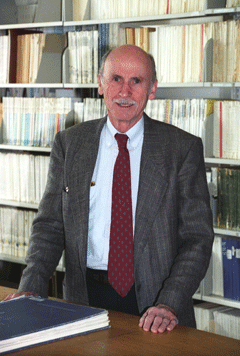
John Firor (Photo: Bob Bumpas/UCAR)
CURWOOD: Back in 1991, during the first year of weekly broadcasts for Living on Earth, our small editorial staff packed up for the very first conference of the Society of Environmental Journalists held in Boulder, Colorado. And perhaps the person who made the largest impression on me at that meeting was John Firor. In a gentle, almost soft-spoken way, Dr. Firor, who was then the head of the National Center for Atmospheric Research in Boulder, spelled out the science of climate change, and how things might change quickly.

John Firor (Photo: Bob Bumpas/UCAR)
John Firor died earlier this month at the age of 80, after a long career of studying the earth, and many years of leadership in planetary science. In an interview in 2000 he spoke with Living on Earth about the debate over climate change, and the lack of understanding by many people.
FIROR: What they don't recognize is that people are dependent on the biological wealth of the earth, ecosystems of one sort or another. And ecosystems are not adaptable. If you change the temperature of a forest, make it higher; many of the tree species cannot reproduce. Their seeds will not germinate at higher temperatures, things of this sort. So the question of whether a climate change is good or bad has been debated, but the shift has occurred over 20 or 30 years to saying it's mostly bad because there are irreversible changes that will affect everything we do, and many of them are detrimental to human occupation of the earth.
CURWOOD: John Firor, speaking with Living on Earth. The long time leader of the national center for atmospheric research leaves behind a generation of earth scientists he led and helped to train. He will be missed.
Related links:
- Living on Earth September, 8 2000: Climate Predictions with John Firor
- "John Firor, 80, Early Voice on Environment, Is Dead" in The New York Times
[MUSIC: Herbie Hancock “Both Sides Now” from ‘River: The Joni Letters’ (Verve—2007)]
CURWOOD: Coming up—science is all wet in a classroom 50 feet under the sea. Stay tuned to Living on Earth.
Max Capacity
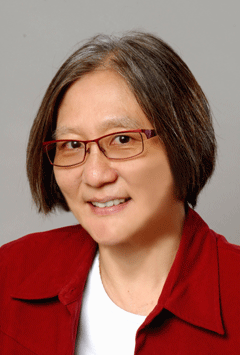
Inez Fung (Photo: Peg Skorpinski)
CURWOOD: It’s Living on Earth. I’m Steve Curwood. The Intergovernmental Panel on Climate Change has released its fourth and final synthesis report for 2007, and the news is not good. Perhaps the best way to summarize it is that we are very likely headed towards human catastrophe. And yet, human global warming gas emissions, especially those of carbon dioxide, continue to rise at alarming rates.
Now there is scientific evidence of an unwelcome complication. For years, the planet has been absorbing about half of the extra CO2 in trees, plants and oceans. But now it seems we are maxing out the capacity of the land and sea to rapidly absorb CO2, and that means more is staying in the atmosphere, making the greenhouse effect stronger and stronger.
Professor Inez Fung co-directs the Berkeley Institute of the Environment and joins me now from the University of California at Berkeley to explain this problem.
FUNG: The CO2—the fossil fuel CO2 that is not in the atmosphere has been absorbed by the land and the ocean. And with global warming, the ability of the land and the ocean to store that carbon is decreasing.
CURWOOD: Why?
FUNG: From the ocean side, we’re heating the ocean from above, which means that we have warmer water on the top and colder water underneath. That means that the whole thing is very well stratified and it’s very difficult to mix the stuff at the top down into the deep. So that builds up—for CO2—that builds up the back pressure of CO2 in the upper layers of the ocean and that just pushes the CO2 back into the atmosphere. Imagine there’s a funnel—that’s the upper ocean—and then there’s a bottleneck to the deep ocean. So when we pour CO2 into the funnel, the upper ocean—the funnel can only hold so much. This is why the ocean is not absorbing all the CO2—there’s a time. It takes a long time to pour all that stuff into that little funnel to get it into the deep ocean to hide it from the atmosphere.

Inez Fung (Photo: Peg Skorpinski)
FUNG: Yes. Because when it gets warmer and warmer I think about the funnel as getting smaller and smaller and the bottleneck—the opening into the deep ocean—gets narrower and narrower. So it’s tougher and tougher to get stuff to hide it from the atmosphere to the deep ocean.
CURWOOD: Now what’s going on on the land? Why are—you know, vegetation absorbs carbon dioxide. I mean, it’s the food for photosynthesis—everything from a little grass to a big tree. You’d think that with more carbon dioxide in the atmosphere that the plants would just be getting bigger and happier.
FUNG: Well, that is true if the plants have enough water and enough nutrients. But first, there’s a finite amount of nutrients so the plants can’t grow forever. And the second is the availability of water. So with global warming, there could be increases in precipitation somewhere and drying elsewhere. But, as you know, my laundry dries faster in the hot sun; the soil dries up faster when the climate is warmer. So there’s less moisture in the soils, the plants don’t function as well, and when the plants don’t function as well, they shut down their stomates to conserve the water because that’s the little opening on the leaves are the exit points for the water. So imagine I’m running around, I’m getting hot, and you tell me to put on a sweater. I cannot sweat anymore. I get hotter. So in a sense they’re starving themselves to death in order to conserve the water.
CURWOOD: We’ve seen then a change in the ability of the ocean to absorb CO2 and the land to absorb CO2. Less and less CO2 being able to go into the ocean because it’s getting warmer. The land less able to absorb CO2 in the plants because the plants are getting warmer and they’re shutting down and I guess, are starting to turn into deserts. How important is this trend and where are we going with it?
FUNG: It’s a scary trend because the less CO2 the land can absorb, the less CO2 the oceans can absorb; the more will remain in the atmosphere. So there are two things—three things happening. You know, the emission rate has gone faster, and because of the bottlenecks in the ocean and because of the ability of plants to store, carbon is decreasing. More is staying—more and more of the fossil fuel CO2 is staying in the atmosphere. So, we expect global warming to be much, much faster.
CURWOOD: Professor Fung, at what point do things really break down?
FUNG: I think you have to define what is breaking down. When I look at the floods and droughts, and the predictions that a hundred year—what we call the 100-year event, you know something that—a severity—a drought severity that happens every 100 years is already happening every 30 years and is projected to happen every ten years, I think things are breaking down already. So we don’t need to have a Dust Bowl to say—to confirm that things are breaking down.
CURWOOD: How well do you sleep at night?
FUNG: Not very well. I think I slept better 20 years ago when I started working on this problem and it was a totally theoretical academic problem. But what we are saying now has not changed over 20 years. So, from a scientist’s point of view, I say ‘great, the theory works.’ I should be happy. But I really wish I was wrong.
CURWOOD: Professor Inez Fung is the co-director of the Berkeley Institute of the Environment and an atmospheric scientist at the University of California near Berkeley. Thank you so much, Professor Fung.
FUNG: Thank you, Steve.
Related links:
- The Berkeley Institute of the Environment
- To see Dr. Inez Fung's presentation on CO2 absorption and climate change, click here.
Acid Oceans
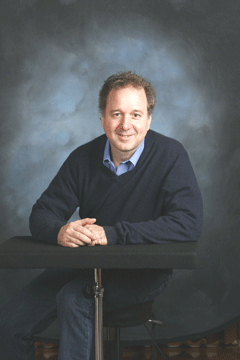
Ken Caldeira (Courtesy of the Carnegie Institution)
CURWOOD: As the atmosphere and oceans reach saturation point for carbon dioxide, things start to get a little sour—acidic actually. That’s right, as greenhouse gases increase, the pH of the ocean changes. Already measurements show the oceans acidifying faster than scientists were expecting.
On the line is Dr. Ken Caldeira, a chemical oceanographer with the Carnegie Institution at Stanford University. Now, Dr. Caldeira, you’ve been studying acid levels in the ocean for a long time. In fact, that was the subject of your PhD dissertation. Can you tell me about that?
CALDEIRA: About 65 million years ago, meteorites slammed into the Yucatan Peninsula and as a result, all kinds of carbon dioxide and sulfuric acid was given off. And that rained down onto the ocean and acidified the surface ocean. And at that time coral reefs and other marine ecosystems that depended on making shells or skeletons out of calcium carbonate disappeared. It took them hundreds of thousands to millions of years to come back.
CURWOOD: So, what’s going on here? As we put more and more CO2 into the atmosphere, more and more is going into the ocean, and what’s it doing to the organisms there?

Ken Caldeira (Courtesy of the Carnegie Institution)
And, as the ocean surface warms, less oxygen is able to dissolve into the ocean, and so some marine organisms may be at least threatened with suffocation by a twin whammy of having warmer water with less oxygen in it and high CO2 levels so their blood is less able to transport oxygen to their muscles. So, we are changing the oceans in ways that it hasn’t been changed in many millions of years and it’s uncertain how marine organisms will react to all this.
CURWOOD: Can you just briefly tell me how you go from a molecule of carbon dioxide in the atmosphere to say, a mollusk not being able to have a shell?
CALDEIRA: What happens when carbon dioxide is absorbed by sea water is that CO2 molecule reacts with an H2O molecule, the water molecule, and in this reaction, it gives off a proton or a hydrogen ion, and that’s what we measure when we measure pH or talk about acidity. And that hydrogen ion that’s given off attacks what’s called a carbonate ion, and that’s what the marine organisms use to build their shells. Calcium carbonate is a calcium ion plus a carbon ion, and so CO2 is absorbed by seawater, it reacts with the seawater and gives a proton and that proton attacks the building blocks that marine organisms need to build their shells and skeletons.
CURWOOD: Intergovernmental Panel on Climate Change—it’s got a synthesis report of all the research that it’s done and how close is that to what you are observing in the change of carbon dioxide in the planet?
CALDEIRA: Atmospheric CO2 emissions and atmospheric CO2 concentrations are both increasing more rapidly than even the most pessimistic of the IPCC scenarios generated just a few years ago. Nobody really saw the rate of development of coal in China and also in India. Also, the high price of oil is pushing people to use less oil and more coal and all of those factors are really increasing CO2 emissions and atmospheric CO2 concentrations beyond what anybody had foreseen.
CURWOOD: So the question then comes: what about geo-engineering? What about something to speed up this process of rebalancing the oceans that we’ve put out of whack?
CALDEIRA: We’ve looked at taking limestone and dissolving it at power plants and so on and we might be able to save certain bays as some kind of marine sanctuary and to have a kind of Disney world of the ocean that could be visible in the future, but the scale at which you would need to counteract the effect all across the ocean would be really huge. It would be taking hundreds of cubic miles of limestone every couple of years. The main thing is—what we would need to do to save the oceans is about the same size as our whole energy system, so it’s easier just to change our energy system.
CURWOOD: Ken Caldeira is a chemical oceanographer with the Carnegie Institution at Stanford University. Dr. Caldeira, thank you so much.
CALDEIRA: Thank you.
Related links:
- Ken Caldeira's chapter on CO2 absorption by the oceans in the IPCC's 2005 global report
- To read a report Dr. Caldeira presented to the National Academy on CO2 and Coral Reefs click here.
Undersea Classroom
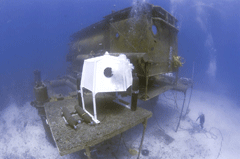
Aquarius with the gazebo - the location where the divers can fill their air tanks when they're running low.(Photo: DJ Roller/Liquid Pictures)
CURWOOD: Studying the effects that a changing climate has on our oceans is exactly what a team of scientists is doing off the coast of Florida. They're actually living beneath the surface of the sea in a laboratory called Aquarius. This team of Aquanauts—that’s right, Aquanauts—is studying coral reefs round the clock for five days, and broadcasting live ‘underwater classroom’ sessions to students across the world via the Web.
[DIVER TAKES A BREATH AND ANNOUNCES ‘I’M BACK OUT HERE ON CONCH REEF AND I WANT TO SHOW YOU SOMETHING THAT MAKES AQUARIUS SPECIAL IS THAT WE CAN DO EXPERIMENTS FROM THE SEA FLOOR’]
CURWOOD: Aquanaut Dr. Mark Patterson is the chief scientist for the Project SeaCAMEL mission. He’s on the line from Aquarius. Hello from those of us above the water, Mark.
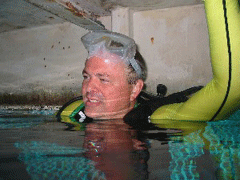
Mark Patterson gets ready to head out for a dive.(Courtesy of the Living Oceans Foundation)
CURWOOD: Or it’s about 60 some odd feet, in other words.
PATTERSON: Yeah, the base is down at 60 feet and then the hatch that we—the moon pool that we enter and leave the habitat from is about 50 feet deep. And we can range as deep as 130 feet deep around the habitat.
CURWOOD: So, tell me what it’s like living down there and what’s the most difficult thing about living in something that’s what—maybe the size of a school bus?

Aquarius (Photo: UNCW/NURC)
CURWOOD: Wait a second—underwater weather?
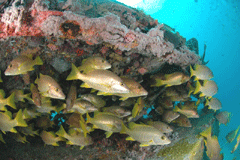
Fish are at home, cozy-ing up to the bottom of Aquarius. (Photo: Annelise Hagan)
PATTERSON: Yeah, we see the ebb and flow and the tides and the currents. We get to see how the ocean changes in a way that you don’t appreciate unless you’re living here.
CURWOOD: How does living in Aquarius offer better research as opposed to doing daily dives?
PATTERSON: There’s two aspects. One is that we can dive a full workday and not have to worry about decompression illness when we go to the surface. So we can get done in ten days what might take us six months or more diving from the surface. The second advantage to doing science here is that we have power from the habitat and we’ve got computers inside the habitat so we can do more sophisticated types of experiments.

Aquarius with the gazebo - the location where the divers can fill their air tanks when they're running low. (Photo: DJ Roller/Liquid Pictures)
PATTERSON: Oh, it’s an ever-changing show at night so there have been some missions in Aquarius where they specifically look at aspects of the biology or the chemistry of the reef that change in the dark hours.
CURWOOD: Now, tell me about your helper there. In particular you have a robotic fish named ‘Fetch?’
PATTERSON: That’s right. Fetch is a free-swimming computer. It’s got no tether, so you program the robot on a mission and then send it off swimming and it surveys what’s going on in the water column over the reef and it can also survey the animals living right on the bottom.
CURWOOD: So what are your specific goals for research while you’re living in Aquarius?
PATTERSON: Well I’m a veteran user. This is my seventh time here. And in the past I’ve used Aquarius to do experiments on how motion in the ocean affects the physiology of the corals and their allies that live on the reef. So, I’ve set up specialized equipment to investigate how the speed of the water moving past the surface of the corals affects their respiration rate and since they’re half plants with symbiotic algae living inside them, corals also photosynthesize during the day so we’ve investigated photosynthesis.
This particular mission—Project SeaCAMEL—is a short mission, where we’re actually trying to do teaching at the university level from the bottom of the sea.
CURWOOD: Dr. Mark Patterson is the chief scientist for the project SeaCAMEL. CAMEL stands for Classroom Aquarius Marine Education Live, teaching students from 60 feet underneath the ocean. Thank you so much, Dr. Patterson.
PATTERSON: Oh, it’s my pleasure. Thank you.
CURWOOD: For a link to the Project SeaCAMEL website, where you can watch the archived undersea classroom broadcasts, go to our website: loe.org.
Related links:
- Living Ocean's Foundation: Project SeaCAMEL (Classroom Aquarius Marine Education Live)
- Virginia Institute of Marine Science
- NOAA's Aquarius
- NOAA's Coral Reef Watch
[MUSIC: Temptations “Papa Was A Rolling Stone,” DJ Jazzy Jeff & Peter Kuzima Soulful Remix from ‘Motown Remixed’ (Motown—2004)]
CURWOOD: Coming up—talking turkey. Ancient breeds make a comeback. But first this emerging science note from Alexandra Gutierrez.
Emerging Science Note/Poplars
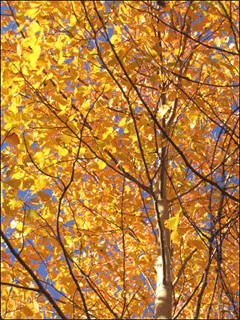
Poplar trees, also known as aspens or Balm of Gileads, turn a dazzling gold during fall in the Ottawa Valley of Eastern Ontario, Canada. (Photo: Flickr/Valley Vistas)
[EMERGING SCIENCE THEME]
GUTIERREZ: What do you get when you cross a tree with a rabbit? A sponge, apparently. By taking a poplar tree, and inserting an enzyme-producing gene from one of the forest’s faster creatures, scientists at the University of Washington have developed a plant that can rapidly soak up toxins from polluted water. These genetically modified trees can then convert the contaminants into harmless byproducts through a process called “phytoremediation” – a word that literally means “restoring balance through plants.”

Poplar trees, also known as aspens or Balm of Gileads, turn a dazzling gold during fall in the Ottawa Valley of Eastern Ontario, Canada. (Photo: Flickr/Valley Vistas)
But while these plants may be an effective solution to cleaning up hazardous spills, it may be a while before poplar forests are planted in polluted areas. Federal laws do not permit commercial growing of genetically modified trees, as there is some concern that they could spread into regular forests.
For now, these poplars will stay in the lab or perhaps monitored government sites. But if University of Washington scientists have their way, a forest of poplars could one day mean cleaner streams.
CURWOOD: You can hear our program anytime on our website or get a download for your mp3 player. The address is L-O-E-dot-O-R-G. That’s loe.org. You can reach us at comments at l-o-e dot org. Once again, write to comments at L-O-E-dot-O-R-G. Our postal address is 20 Holland Street, Somerville, Massachusetts, 02144. And you can call our listener line anytime at 800-218-9988. That's 800-218-99-88.
[MUSIC: Stanton Moore “Water From An Ancient Well” from ‘III’ (Stanton Moore—2006)]
CURWOOD: And you’re listening to Living on Earth.
ANNOUNCER: Support for Living on Earth comes for the environmental health desk at Living on Earth comes from the Cedar Tree Foundation. Support also comes from the Richard and Rhoda Goldman Fund for coverage of population and the environment. This is Living on Earth on PRI: Public Radio International.
Let's Talk Turkey
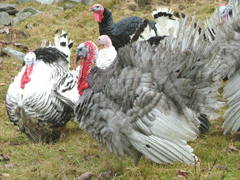
(Photo: Marc Renaghan)
CURWOOD: It’s Living on Earth, I’m Steve Curwood.
[MUSIC: Joe Pipik “Turkey Blues” from ‘Give Up the Gobble’ (Self released—1983)]
CURWOOD: Yes, at Thanksgiving, the turkey reluctantly takes pride of place on dinner tables across America. Today 99 percent of the turkeys Americans eat over the holidays are the same species—the broad-breasted white. But as people increasingly choose organic and locally grown food, interest in old-fashioned breeds of livestock, including turkeys, is rising.
Ancient varieties of turkeys are enjoying a come-back—as Living on Earth’s Bobby Bascomb discovered down on a farm in Massachusetts, the state known for the very first Thanksgiving.
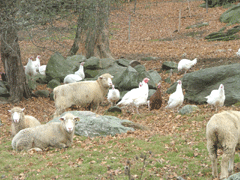
Turkey and sheep are pastured together at the Stillman turkey farm. Turkeys eat insects that would otherwise bother the sheep. (Photo: Bobby Bascomb)
[TURKEY GOBBLES]
BASCOMB: Kate Stillman runs a family farm. Behind her mustard-colored farmhouse small fields bordered by stone walls are dotted with sheep and turkeys. But these are no ordinary turkeys.
STILLMAN: If you look at the heritage turkeys, their heads are beautiful! These are blue slates that we're looking at and most of their head is this iridescent light sky blue color with a red neck and I mean, the colors are fantastic but they're very reptile looking.
[TURKEY GOBBLES]
BASCOMB: Kate and her husband Aidan raised 50 heritage turkeys this year. They also raised about 200 of the more conventional white turkeys.

Where did its face go? Many species of heirloom turkeys have brightly colored wrinkly skin. (Photo: Marc Renaghan)
BASCOMB: But a trim turkey with a small breast isn't what most people want on their Thanksgiving table.
SMITH: For whatever reason, Americans love the breast and the white meat.
BASCOMB: Andy Smith is a turkey historian. He wrote the book on turkeys—literally. His book, “Turkey: An American Tale,” traces the history of our favorite fowl. The first European explorers took wild American turkeys back to Europe where breeders started to raise them—for their feathers.
SMITH: And hence their names: black and white and Bourbon red and buff and slate, etcetera. The exception to that of course was the bronze turkey, which was the largest heritage breed and had the largest breast.

A Blue Slate tom turkey struts his stuff. (Photo: Marc Renaghan)
SMITH: They've had their toes snipped off a few days after birth. They've had their beaks snipped off in order to prevent turkeys from attacking each other, which they do in confined spaces.
BASCOMB: Milton Madison, senior agricultural economist at the USDA, says most turkeys are kept in big barns. And as for removing beaks and toes, he describes it as more of a turkey pedicure.
MADISON: At times the toes and beaks will be trimmed slightly so that they're a little more blunt. Similar to trimming your finger nails so that you don't scratch yourself or others around you.
[TURKEYS GOBBLE]
BASCOMB: Raising free-range heirloom turkeys is more expensive than mass producing them. They cost three times as much to buy as babies, and take several months longer to mature. A heritage turkey from the Stillman’s will cost $100, compared with about $60 for the traditional birds. But people are willing to pay. Don Schrider of the American Livestock Breeds Conservancy says that’s going to help save these birds from extinction.
SCHRIDER: If people eat heritage turkeys then more breeding stock is maintained and then the next season more heritage turkeys can be produced. And it actually gives them a job and the population grows.
BASCOMB: The number of heirloom birds has increased eight fold in the last ten years. Farmer Kate says people like the taste of the old-fashioned birds.
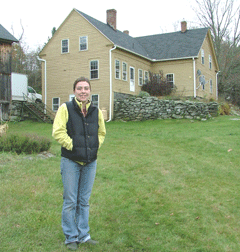
Kate Stillman is a farmer in Hardwick, Massachusetts. (Photo: Bobby Bascomb)
STILLMAN: The heritage birds have a higher percentage of dark meat, which for dark meat lovers—I mean, that’s usually the more flavorful part of the turkey. Almost everybody who ordered a turkey from us last year has ordered two turkeys. So I don't know if they're thinking they're going to pop one in the freezer and keep it for Christmas or something like that but people raved about the turkeys.
BASCOMB: The demand's been so great this year that the Stillmans actually ran out of heirloom birds.
STILLMAN: You know, I had somebody call me this morning and she said to me, ‘oh please Kate, can we get a turkey from you, we've been away I really wanted to call.’ And she's been a really good customer. We were supposed to be saving two turkeys for my aunt for Thanksgiving so I called my mother and I’m like, ‘well you guys are only getting one turkey because I really couldn't say no to her.’
BASCOMB: And so come Thursday the Stillmans might go without a heritage turkey at the center of their table, but they’ll have made a lot of Massachusetts families very happy. For Living on Earth, I'm Bobby Bascomb.
Related links:
- The National Turkey Federation
- Stillman's at the Turkey Farm
- United States Department of Agriculture
- Andrew Smith’s book, The Turkey; An American Story
Cranberries Take Centerstage
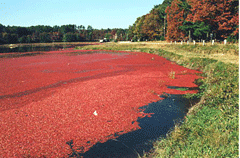
Cranberries are one of three native fruits of North American that are grown commercially. (Courtesy of U.S. Census Bureau)
CURWOOD: That first Thanksgiving table in Plymouth, Massachusetts featured a food more American than apple pie—the cranberry, or at least that’s how the legend goes. Cranberries are one of the most healthful foods on the holiday table. But as Living on Earth’s Emily Taylor found when she headed to the cranberry bogs, that’s not why people pile on the cranberry sauce.
CAKOUNES: My name is Leo Cakounes and I run Cape Farm Supply and Cranberry company.
[MUSIC: Sue Keller "Cranberry Stomp" from 'Ol' Muddy: Riverboat Ragtime-Era Piano Sounds' (HVR - 2003)]
CAKOUNES: Naturally what I think of when I hear the word cranberry is my mortgage payment because basically that's what we do for a living is grow cranberries.
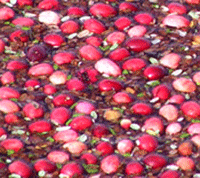
Cranberries were originally called “Craneberries” by the Pilgrims because their small, pink blossoms reminded them of the head and bill of a Sandhill crane. (Courtesy of Massachusetts Department of Agricultural Resources)
WOMAN: Decoration with cranberries. I decorate during Christmas time with cranberries myself.
MAN: I suppose cranberry sauce and having Thanksgiving dinner is definitely the theme.
CAKOUNES: There's a lot of nostalgia with cranberries, associated with Thanksgiving and that's understandable but for us it's a crop that we grow for the purpose of making a living.
MAN: Well, I used to go wild cranberry picking on the Cape with my dad. He'd always take me up on the dunes and show me all the hotspots.
WOMAN: Umm fifth grade. I don’t know, I think I had a dream about a bog. I don't know. It was kind of weird, but fifth grade.
GIRL: When I think of cranberries I think of coyotes because on Cape Cod there's tons of cranberry bogs and around them thousands of coyotes live there.
MAN: Since I was a child. I think I was fascinated the first time I saw a cranberry bog.

Cranberries are one of three native fruits of North American that are grown commercially. (Courtesy of U.S. Census Bureau)
CAKOUNES: The harvesting process of cranberries is probably the most interesting process because that's the time of year most people want to come and see a cranberry bog.
WOMAN: (singing) Did you ever go to the cranberry bogs? Some of the houses are hewed out of logs. The walls are of boards that are sawed out of pine. That grow in this country called cranberry mine.
CAKOUNES: There's two basic kinds of harvesting. There's the dry harvest. The dry harvest is done first, usually mid September. It's done when the bog has to be completely dry, that means no dew or anything on it. The dry harvesting produces what's called the fresh fruit. Which is the large cranberries that you buy in the store that the consumer ends up buying, the actual cranberry itself.
WOMAN: He eats them plain, right out of the box. He and his sister both love to eat the cranberries plain.
MAN: I actually eat them plain a lot. I remember going to the museum and seeing them bounce down the little stairway for grating. We'd just pop them in our mouth.
WOMAN: I feel very puckered up and I feel like I'm going to eat something sour. I'm not interested at all (laughs).
MAN: The first time I had real cranberry sauce made with whole cranberries, I was blown away. It was marvelous stuff.
CAKOUNES: The second kind of harvest, which is probably most familiar to people is called the ‘wet harvest.’ And we drive a machine out on the bog which beats the berries off the vine and then coral them with either boards or a cranberry barrier. And then those berries are pumped or loaded into an open truck with a conveyor and then they're shipped to the supplier. And they're actually called processed fruit. Those berries become your concentrate for drinks. They become your cranberry sauce.
MAN: For years I thought cranberry sauce was the stuff shaped like a can.
WOMAN: When I was a kid the only cranberries we ate were out of a can. But my mom would just put it on the plate like, whole in this gelatinous mass, you know. And she'd open up one end and it would just ooze out the other end and be like slurping sounds.
MAN: Canned cranberry sauce is almost never good.
WOMAN: The stuff in a can. You just sort of squish it out of the can and it sits there and giggles on the plate.
MAN: Slice it.
WOMAN: That's right and you slice it, you can't even serve it with a spoon.
CAKOUNES: The market for fresh fruit hasn't really increased that much. There are still some people out there who are still dedicated to buy fresh cranberries and serve them on their Thanksgiving table and we think that's wonderful. But we are really working hard producing new products. Hoping we can get into the candy market and the cereal market which will pretty much help us year round as opposed to waiting for one Thanksgiving dinner to pay our bills.
CURWOOD: Our cranberry audio postcard was produced by Emily Taylor and Dennis Foley.
Related links:
- Cape Cod Cranberry Growers’ Association
- Bog owner Leo Cakounes’ Cape Farm and Cranberry Company
- Cranberry Marketing Committee - USA
Not So Great Migrations
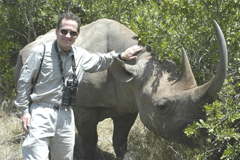
Professor David Wilcove with a rhinoceros. (Photo: Nathan Gregory)
[SOUNDS OF A TENNESSEE WARBLER WARBLING]
CURWOOD: That’s a Tennessee warbler—a song of summer now silent in America’s woodlands as birds head south for warmer weather and food. But the huge flocks of thrushes and swallows and warblers that used to crowd the skies are thinning as they and many other creatures are now finding it difficult to complete their migrations.
Joining me now is David Wilcove, Professor of Ecology and Evolutionary Biology at Princeton University. He’s written a new book called “No Way Home: The Decline of the World’s Great Animal Migrations.” Hello, Professor.
WILCOVE: Hello.
CURWOOD: Tell me, why is migration so important?
WILCOVE: It’s important for a variety of reasons. It’s an absolutely magical thing to see. It inspires like few other phenomena in nature. But it’s also important ecologically because the movements of these animals over great distances provide a range of benefits to humanity. Birds migrating through the forests eat insects that would otherwise harm the trees; salmon migrating upstream and dying basically transport nutrients from the oceans to the rivers; and monarch butterflies moving south in the fall are basically pollinating plants as they go along.
CURWOOD: So, the forest needs the fish?

Professor David S. Wilcove of Princeton University(Photo: (c) Jon Roemer/Woodrow Wilson School)
CURWOOD: Into the grapevine and then into the wine that you and I get to drink.
WILCOVE: That’s right. So some of the wine might have a slightly salmony taste.
CURWOOD: What is it that attracted you to study migrations, David Wilcove?
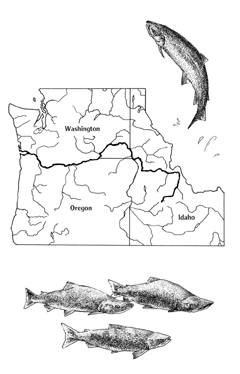
Salmon travel from Idaho streams to the Pacific Ocean. (Photo: Louise Zemaitis)
CURWOOD: Tell me about some of the challenges that some of these migratory species face.
WILCOVE: Migratory species have to get from one location to another often at great distance, and they have to contend with a loss of habitat on their breeding grounds, on their wintering grounds, and on the areas where they stop and rest in between. They have to contend with disease, with climate change, and they also run the risk of being harvested by humans because they often aggregate in large numbers, like a herd of bison or salmon moving upriver. All of these threats have driven many migratory species way down in numbers.
CURWOOD: So, tell me about the most arduous journeys that creatures make to migrate.
WILCOVE: On land, there’s a population of prong-horned antelope that migrates from Grand Teton Park in Wyoming down to the Wind River Range and they have to cross 300 miles of land that is now riddled with fences, oil and gas developments, suburban housing developments, and as a result, there are only a couple hundred prong-horned antelope left that are able to make the journey. We have salmon in the Northwest that migrate over 900 miles upstream, and they have to contend with major power damns, with logging operations that damage the streams.
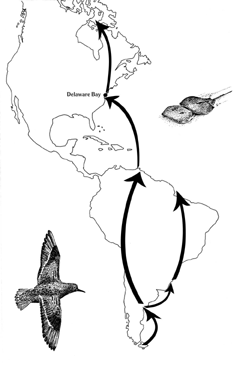
The red knot's epic migration - from pole to pole.(Photo: Louise Zemaitis)
CURWOOD: So, I noticed in your book you write about dragonflies and a device to track a dragonfly. Tell me more about this device. I mean, a dragonfly doesn’t weigh that much. I mean, what exactly was the technology that was used to put a tracking device on these dragonflies?
WILCOVE: I was in Cape May, New Jersey with my colleague Martin Wikelski, and he has pioneered the study of migratory birds by putting very small transmitters on them. And we were looking at the migration of dragonflies in Cape May. Millions of dragonflies migrate through Cape May. And I said ‘do you think we could find a transmitter small enough to fit on a dragonfly?’ And he said he though the people he worked with could come up with something. And, sure enough they did. They developed a tiny radio transmitter weighing about one 100th of an ounce that we could glue onto the belly of a dragonfly, release the dragonfly, and then follow it in a light airplane as the dragonfly migrated south. And we tracked individual dragonflies going 80 to 100 miles in a day.

Professor David Wilcove with a rhinoceros. (Photo: Nathan Gregory)
CURWOOD: At the end of the day, what can really be done to protect migratory species?
WILCOVE: The challenge in protecting migratory species is twofold. You’ve got to get different states, agencies, nations, to cooperate, to work together. And you have to protect the species while they’re still common because that’s part of the glory of migration—the sheer abundance of the animals. So the core challenge is getting different jurisdictions to cooperate, to plan together, and it’s getting people concerned about these species before they become endangered. Because once they’re endangered, for all intents and purposes, the glory of the migration has been lost.
CURWOOD: So, what can I do as an individual?
WILCOVE: As an individual, you can of course, play an active role in land use decisions in your community and in the country as a whole. That is to say you can protect open space and parks, which will be important for migratory species. You can be an educated consumer to make sure that the seafood you purchase did not come at the expense of sea turtles, which are often drowned in commercial fishing operations. And of course, you can advocate greater assistance to other countries for their conservation because after all, every acre of forest that we protect, in Mexico, or in Central America, is likely to be an acre of forest that provides songbirds for us in the United States in the spring.
CURWOOD: Ecologist and Princeton University professor David Wilcove’s new book is called “No Way Home.” Thank you so much, Professor Wilcove.
WILCOVE: It’s been a pleasure.
Related links:
- "No Way Home" from Island Press
- David Wilcove at Princeton University's Department of Ecology and Evolutionary Biology
[MUSIC: Various Artists/ Patty Larkin “Bound Brook” from ‘La Guitarra’ (Vanguard Records—2005)]
CURWOOD: Next time on Living on Earth—the presidential candidates focus on global warming and America's energy future. We kick off the first in our series with Senator Hillary Clinton.
CLINTON: We can slow global warming and create thousands—I would argue, millions—of new good jobs. We can protect our security and our environment.
CURWOOD: Presidential hopeful Hillary Clinton—on the next Living on Earth.
Living on Earth is produced by the World Media Foundation. Our crew includes Ashley Ahearn, Bobby Bascomb, Eileen Bolinsky, Bruce Gellerman, Ingrid Lobet, Helen Palmer, Emily Taylor, and Jeff Young. Our interns are Alexandra Gutierrez and Mitra Taj. Jeff Turton is our technical director. Alison Lirish Dean composed our themes. You can find us anytime at loe.org. I’m Steve Curwood. Thanks for listening.
ANNOUNCER: Funding for Living on Earth comes from the National Science Foundation, supporting coverage of emerging science. And Stonyfield Farm: organic yogurt and smoothies. Stonyfield pays its farmers not to use artificial growth hormones on their cows. Details at Stonyfield.com. Support also comes from you our listeners, the Ford Foundation, the Town Creek Foundation, the Oak Foundation, supporting coverage of climate change and marine issues, and Pax World Mutual Funds, socially and environmentally sustainable investing. Pax World: for tomorrow. On the Web at PaxWorld.com.
ANNOUNCER 2: PRI: Public Radio International.
Living on Earth wants to hear from you!
Living on Earth
62 Calef Highway, Suite 212
Lee, NH 03861
Telephone: 617-287-4121
E-mail: comments@loe.org
Newsletter [Click here]
Donate to Living on Earth!
Living on Earth is an independent media program and relies entirely on contributions from listeners and institutions supporting public service. Please donate now to preserve an independent environmental voice.
NewsletterLiving on Earth offers a weekly delivery of the show's rundown to your mailbox. Sign up for our newsletter today!
 Sailors For The Sea: Be the change you want to sea.
Sailors For The Sea: Be the change you want to sea.
 The Grantham Foundation for the Protection of the Environment: Committed to protecting and improving the health of the global environment.
The Grantham Foundation for the Protection of the Environment: Committed to protecting and improving the health of the global environment.
 Contribute to Living on Earth and receive, as our gift to you, an archival print of one of Mark Seth Lender's extraordinary wildlife photographs. Follow the link to see Mark's current collection of photographs.
Contribute to Living on Earth and receive, as our gift to you, an archival print of one of Mark Seth Lender's extraordinary wildlife photographs. Follow the link to see Mark's current collection of photographs.
 Buy a signed copy of Mark Seth Lender's book Smeagull the Seagull & support Living on Earth
Buy a signed copy of Mark Seth Lender's book Smeagull the Seagull & support Living on Earth

